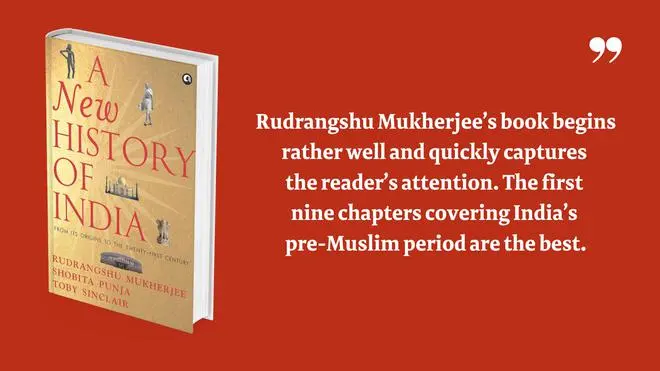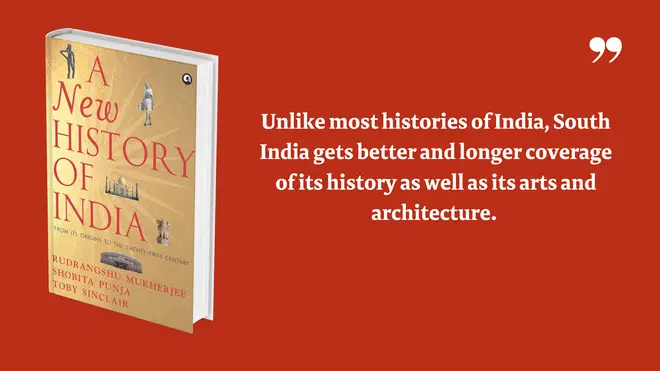It takes a brave person to attempt to compress the history of a country as diverse and ancient as India into one volume. There is so much ground to cover and however judicious and eagle-eyed the writer might be, there will inevitably be some hyping of the trivia and missing out on the important.
Careful editing and reviewing, of course, minimises such risk. John Keay’s book India-A History from the Earliest Civilizations to the Boom of the Twenty-first Century, first published in 2000, is an excellent example of this.
Also read
It moves the reader briskly in an uncomplicated and linear fashion through over 5,000 years of India’s rich past, starting with the Harappan civilisation to almost today. Its 2022 edition is arguably the best single-volume history of India and remains the one to beat. But now there is a challenger.
Twenty-three years after Keay’s book first appeared, two Indians and a Scot have joined hands to bring us another ambitious single-volume history of India, covering not only its historical past but its geological and anthropological origins and prehistory as well.
- Also read: Exploring India’s diversity
At a mere 455 pages, A History of India: From its Origins to the Twenty-First Century by the well-known historian Rudrangshu Mukherjee (along with Shobita Punja and Toby Sinclair) is a much shorter volume than Keay’s tome.
Mukherjee’s book begins rather well and quickly captures the reader’s attention. The first nine chapters covering India’s pre-Muslim period are the best. They cover much ground through lively accounts of the Vedas, and Upanishads as well as the emergence of Jainism and Buddhism.

Society in the Mauryan period
The rich Indo-Greek encounters following Alexander’s incursion into India in 326 BCE are inadequately covered in Mukherjee’s book. However, the Mauryan period gets more comprehensive treatment.
While one misses the excitement of the re-discovery of India’s greatest ruler, Ashoka the Great, by James Princep, Mukherjee’s book makes up for it by giving us a fair idea of society and the economy in the Mauryan period. Its account of the Indian classic on statecraft, the Arthashastra is fascinating.
Unlike most histories of India, South India gets better and longer coverage of its history as well as its arts and architecture. Its rich maritime traditions have been well brought out not the least through an account of the excavations at Pattanam in Kerala and Indo-Roman interactions in antiquity on South India’s Western and Eastern coasts.
- Also read: How Star shone bright in India
It is rather odd therefore to see that in a book rich in its treatment of antiquity two of India’s greatest epics, the Ramayana and the Mahabharata, are not touched upon.
While Mukherjee rightfully highlights the positive aspects of Islamic rule in India — its impact on art, architecture, literature, and religious movements — he dodges a discussion on the destruction of ancient India’s finest institution of higher learning at Nalanda by Bakhtiyar Khalji and the razing of Hinduism’s holiest shrines at Somnath, Mathura, and Varanasi by various Muslim invaders and rulers — Muhammad of Ghazni, Sikander Lodi, and Aurangzeb.

Ahiliya Bhai Holkar’s reconstruction of the Kashi Vishwanath temple without destroying the Gyanvapi Mosque that Aurangzeb constructed in place of the temple he had brought down in 1669 is a remarkable example of tolerance and forgiveness Mukherjee and his co-authors choose to ignore.
The coverage of the British period of India’s history is selective and poor. The 1857 revolt is well highlighted as is its grisly aftermath. The massacre at Jallianwala Bagh gets the good coverage it deserves.
However, the rich legislative traditions to which many Indians like Ambedkar, Rajagopalachari, and Gobind Ballabh Pant, among several others, contributed from the early 1900s onward enabling India to emerge as a parliamentary democracy are ignored as also the wide-ranging consultations — including three round-table conferences — leading to the enactment of the 1935 Government of India Act on which our Constitution is based.
Aspects of British rule ignored
There is hardly a favourable reference to the better aspects of British rule — the institutions they set up, the railways they brought in, or the vast irrigation networks that contributed to India’s agricultural advancement.
The spectacular contributions of institutions set up in colonial times and which serve us well to this day such as the Survey of India and the Archaeological Survey of India are glaringly ignored.
The coverage of the freedom movement led by Mahatma Gandhi is sketchy. The book has other shortcomings that cannot be missed.
- Also read: From diplomacy to Raisina Hill
Anyone familiar with India’s contemporary history will, on reading this volume discover, so much of what is important in the lead-up to India’s independence and its aftermath has been (deliberately?) missed out by Mukherjee.
Glaringly, the extraordinary role played by Sardar Patel and his assistant VP Menon in bringing around 600 princely states into the Indian Union finds no place in Mukherjee’s book.
One wonders how could so important development have been ignored when it had, as the historian Ian Copland noted, “swelled the area of the new Indian state by over half a million square miles and its population by nearly 90 million people, redrew the political map of the subcontinent and overthrew an entire governing order.”

The book’s index is inadequate and at times misleading and the bibliography is too short. The volume is also sloppily edited. How could an assertion that “the Northeast consists of seven separate states,” be made when there is an eighth one in Sikkim?
Mukherjee’s book is interesting but is poor history in the things it chooses to cover and in its selective omissions of the important and the contentious. In thoroughness of research and as a great read, it is no match to John Keay’s India.
Check out the book on Amazon.
(The reviewer, taught public policy and contemporary history at IISc-Bengaluru)









Comments
Comments have to be in English, and in full sentences. They cannot be abusive or personal. Please abide by our community guidelines for posting your comments.
We have migrated to a new commenting platform. If you are already a registered user of TheHindu Businessline and logged in, you may continue to engage with our articles. If you do not have an account please register and login to post comments. Users can access their older comments by logging into their accounts on Vuukle.